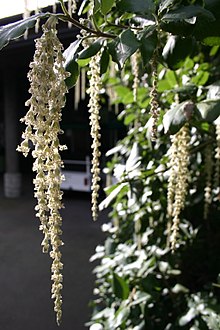Garrya
| Garrya | |
|---|---|

| |
| Garrya catkins in February at Woodland Park Zoo in Seattle, Washington. | |
| Scientific classification | |
| Kingdom: | Plantae |
| Clade: | Tracheophytes |
| Clade: | Angiosperms |
| Clade: | Eudicots |
| Clade: | Asterids |
| Order: | Garryales |
| Family: | Garryaceae |
| Genus: | Garrya Douglas ex Lindl. |
| Synonyms[1] | |
| |
Garrya is a genus of flowering plants in the family Garryaceae native to Mexico, the western United States, Central America and the Greater Antilles.[1] Common names include silk tassel and tassel bush.[2][page needed]
They are evergreen dioecious wind-pollinated shrubs growing to 1–5 m (3–16 ft) tall. The leaves are arranged in opposite pairs, and are simple, leathery, dark green to gray-green, ovate, 3–15 cm (1–6 in) long, with an entire margin and a short petiole. The flowers are gray-green catkins, short and spreading when first produced in late summer; the male catkins becoming long (3–20 cm (1–8 in)) and pendulous in late winter when shedding pollen; the female catkins usually a little shorter and less pendulous. The fruit is a round dry berry containing two seeds.[3]
Species[]
- Garrya buxifolia – dwarf silktassel; western Oregon, northern California
- Garrya congdonii – chaparral silktassel; California
- – Guatemala
- Garrya elliptica – coast silktassel, wavyleaf silktassel; western Oregon, western California
- Garrya fadyenii – Fadyen's silktassel; Cuba, Jamaica, Hispaniola; naturalised in Leeward Islands
- Garrya flavescens – ashy silktassel; California and Baja California, northeast to Utah and New Mexico
- Garrya fremontii – bearbrush silktassel; southern Washington, Oregon, California, northwestern Nevada
- – Coahuila, Tamaulipas, Nuevo León
- – Baja California
- – laurelleaf silktassel; widespread from Chihuahua and Tamaulipas south to Panama
- – Durango, Jalisco, Guerrero, Michoacán, Oaxaca, Morelos, Mexico State, Distrito Federal de México
- Garrya ovata – eggleaf silktassel; New Mexico, Texas, Chihuahua, Oaxaca
- – willowleaf silktassel; Baja California, Baja California Sur
- Garrya veatchii – canyon silktassel; California, Baja California
- Garrya wrightii – Wright's silktassel; Arizona, New Mexico, Texas, Chihuahua, Sonora, Durango, Coahuila
Cultivation and uses[]
Some species, notably Garrya elliptica, are widely cultivated in gardens for their foliage and the catkins produced in late winter. They are frequently grown against a wall, or as a windbreak in coastal areas.[4] Male plants are more widely grown, as their catkins are longer and more attractive; one such cultivar, G. elliptica 'James Roof', has catkins up to 35 cm (14 in) long. The hybrids G. × issaquahensis (G. elliptica × G. fremontii) and G. × thuretii (G. elliptica × G. fadyenii) have been bred for garden planting.
References[]
- ^ a b Govaerts, R. "Garrya Douglas ex Lindl". World Checklist of Selected Plant Families. Royal Botanic Gardens.
- ^ Gledhill, David (1996) [1989]. The Names of Plants (2nd ed.). Cambridge, UK: Cambridge University Press. ISBN 9780521366755.
- ^ Dahling, Gerald V. (1978). "Systematics and evolution of Garrya". Contributions from the Gray Herbarium of Harvard University. Harvard University Herbaria (209): 1, 3–104. JSTOR 41764821.
- ^ Brickell, Christopher; Royal Horticultural Society (2008). RHS A–Z Encyclopedia of Garden Plants. 2 (3rd ed.). United Kingdom: Dorling Kindersley. p. 1128. ISBN 978-1405332965.
External links[]
- Garryales
- Flora of North America
- Asterid genera
- Asterid stubs